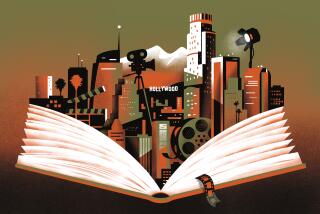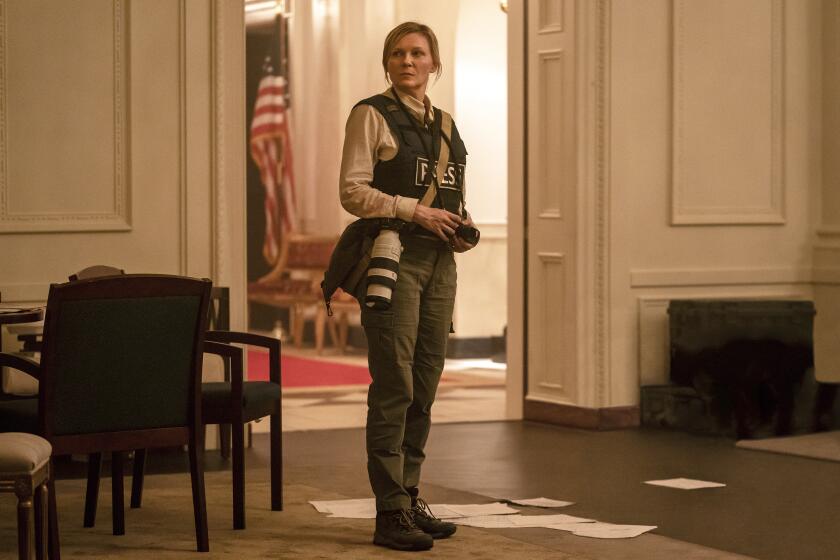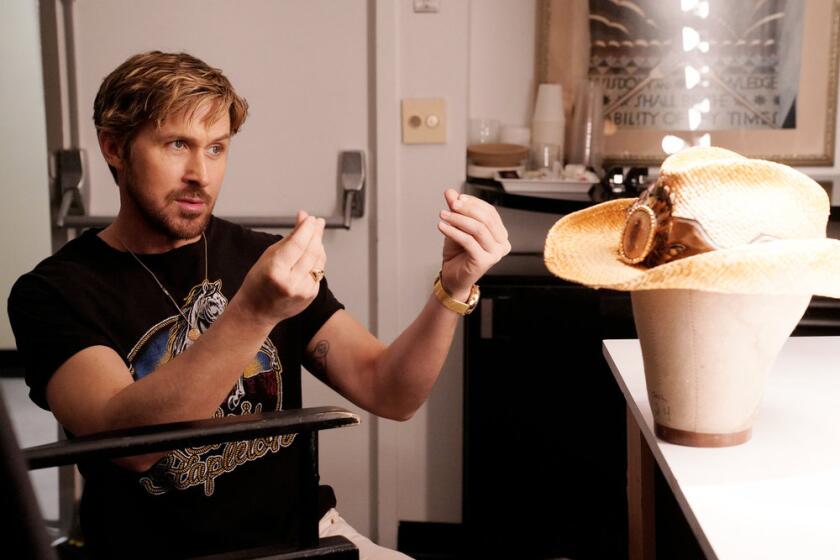From the Archives: ‘Harry Potter and the Sorcerer’s Stone’ film is imaginative and faithful but shuns any risk-taking
Today marks the 20th anniversary of the first book in J.K. Rowling’s “Harry Potter” series. From our archives, we’re resurfacing The Times’ original reviews of each “Harry Potter” film adaptation. The following review of “Harry Potter and the Sorcerer’s Stone” was first published on Nov. 16, 2001.
When you spend in the neighborhood of $125 million on the most widely anticipated literary adaptation since “Gone With the Wind,” you want to get what you paid for. With “Harry Potter and the Sorcerer’s Stone,” Warner Bros. has gotten just what it wanted, and that is simultaneously satisfying news and something of a disappointment.
When a studio is dealing with an author like J.K. Rowling, whose books about a young boy’s quest to be the wizard he was meant to be have sold more than 110 million copies in 200 countries, the overriding mandate is to protect the franchise. Like hulking NFL offensive linemen signed on to safeguard a valuable quarterback, every “Harry Potter” hire, from director Chris Columbus on down, was made with an eye toward ensuring that those hordes of fanatical fans weren’t disappointed. As screenwriter Steve Kloves told Vanity Fair, “I’d be lying if I said you’re not aware that you’re adapting the most beloved book in the world.”
MORE: Every ‘Harry Potter’ movie review »
Inevitably, the result is a remarkably faithful copy of the book that treats the text like holy writ (hence its 2-hour-and-33-minute length.) From the gold in Gringotts, the safe-as-houses goblin-run bank, to the centaur lurking in the forbidden forest that adjoins Hogwarts School of Witchcraft and Wizardry, so much is presented just as written that “Harry Potter and the Sorcerer’s Stone” starts to resemble one of those fiendishly exact replicas of great works of art that Sunday painters can be seen working on in galleries of museums.
For those who remember the mincemeat Hollywood has made out of their favorite books, this fidelity has a lot going for it. Certainly “Harry Potter” has nothing in common with “The Sea Beast,” the 1926 version of “Moby-Dick” that gave Captain Ahab a last name and a girlfriend he comes home to after killing the white whale, a young woman who says, in the film’s most unforgettable line, “Why Ahab Ceeley, you’re crying.”
But copies, even ones as impressive as “Harry Potter,” can by definition only go so far. Copies don’t provoke passionate responses of either agony or ecstasy; copies don’t leave much to object to or get excited about. Ideally, as in something like “The English Patient” or “The Godfather,” a film will extend or even transcend the book’s emotional territory and bring a touch of cinematic poetry to the proceedings. But to get that, you have to take risks, and risk is something no one associated with this project wanted anything to do with.
Still, it won’t do to be unyieldingly grumpy about “Harry Potter.” It’s easily the best film of Columbus’ lightweight but lucrative career (“Home Alone,” “Mrs. Doubtfire,” “Stepmom”), and its crack production team (including the costume designer from “A Little Princess,” Judianna Makovsky; and two of “The English Patient’s” Oscar winners, cinematographer John Seale and production designer Stuart Craig) has re-created Hogwarts and environs with a fine visual brio.
And there are moments--not nearly as many as we’d like, but still moments--when some of the magic of the books rubs off on the screen. The curmudgeonly way the sorting hat goes about its business of assigning new Hogwarts students to their houses, the mad jumble of Diagon Alley, the rough-and-tumble excitement of the school’s signature game, Quidditch; all are conveyed as we might have hoped.
What “Harry Potter” also has going for it is its casting of the trio of Harry and his pals. Amazingly, only one of them, Daniel Radcliffe, who brings an even-keeled decency to the role of 11-year- old Harry, has had professional experience, playing David Copperfield in a BBC television production. Though you wouldn’t guess it (director Columbus’ experience with child actors is probably a factor here), neither Emma Watson as the smarty-pants Hermione Granger or Rupert Grint as the loyal Ron Weasley had acted outside school plays before.
Though the “Harry Potter” team had its pick of performers for the adult parts, not all its choices are as successful. Only one actor brings his role completely to life, and that is the first adult cast as well as a personal choice of author Rowling: Robbie Coltrane as 8- foot-tall Hagrid, Hogwarts’ formidable Keeper of Keys and Grounds.
Although some of his fellow adults seem to be overly conscious of the responsibility of re-creating universally beloved characters, Coltrane’s lively, unabashed spirit and sense of fun make Hagrid as real as a hairy half-giant who carries a pink umbrella could possibly be. The inspiration, he’s told journalists, came from Rowling herself, who suggested he think of his character “as one of those really big Hells Angels who gets off a motorbike and then starts talking about how his garden is coming.”
It’s Hagrid who brings the baby Harry to live with the dreadful Dursleys, his only living relatives but Muggles (non-magicians) of the worst sort. For though he doesn’t find out until Hagrid fills him in, Harry is not only a potentially powerful wizard but a celebrated one as well: He alone survived the battle that killed his parents, an attack by the dread Voldemort, a sorcerer so powerful that once he went over to the dark side, no one so much as dared to say his name.
What happens to Harry after Hagrid reenters his life on his 11th birthday is as familiar to Potterites as the stations of the cross to a different category of believer. One of the smartest moves the film’s brain trust made was to hire screenwriter Kloves, something of a wizard in his own right (“The Fabulous Baker Boys,” “Wonder Boys”), to pare the book down and do so without resorting to cliches or clunky, overly heartfelt dialogue.
As for the other adult co-stars, they are all acceptable, and some are better than that. John Hurt in a small role as the wandmaster Ollivander and Ian Hart as Professor Quirrell come off best, with Maggie Smith as Professor McGonagall and Alan Rickman as Professor Snape one level down, while Richard Harris as headmaster Albus Dumbledore plays his part more like someone waving from a float in the Rose Bowl parade than as a flesh-and-blood individual.
Other nagging problems exist for “Harry Potter” as well. It has, as other Columbus films do, a tendency to underline its emotions, something a relentless John Williams score does nothing to counteract. And its desire to eliminate rough edges, to make everything as perfect and pretty as possible, is typified by casting the poised and lovely Watson as Hermione, a character unglamorously described in the book as having “a bossy sort of voice, lots of bushy brown hair and rather large front teeth.”
Doing its best to overcome obstacles is the film’s remarkable look, its ability to make Diagon Alley, a kind of shopping mall for wizards, seem like an actual place. Combining a wide variety of British locations and a small handful of special-effects houses (Industrial Light & Magic, Rhythm & Hues and Sony Pictures Imageworks among them) has given “Harry Potter” a seamless visual style.
It is the film’s success in re-creating that world that points out its happiest accomplishment, the ability to remind us of what we loved about the book. What saves “Harry Potter and the Sorcerer’s Stone” is what created it in the first place: J.K. Rowling’s enrapturing imagination. At those sporadic moments when the film allows us to share in Harry’s wonder, it lets us recapture our own as well. We all would love to go to Hogwarts, and now, albeit imperfectly, we can.
‘Harry Potter and the Sorcerer’s Stone’
Rating: PG, for some scary moments and mild language. Times guidelines: Relatively mild, but the action gets more intense as it goes along.
More “Harry Potter” film reviews from the archives:
‘Harry Potter and the Chamber of Secrets’ doesn’t capture the well-balanced tone of the book
‘Harry Potter and the Prisoner of Azkaban’ film comes close to capturing the essence of the books
‘Harry Potter and the Goblet of Fire’ finally gets Harry Potter right
More to Read
Only good movies
Get the Indie Focus newsletter, Mark Olsen's weekly guide to the world of cinema.
You may occasionally receive promotional content from the Los Angeles Times.







